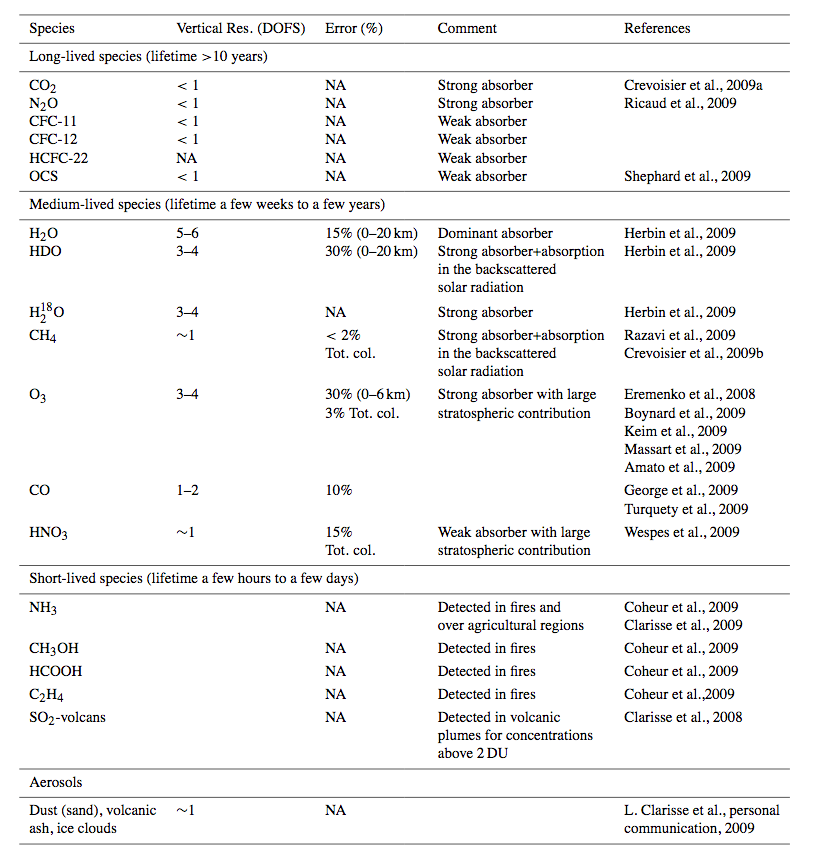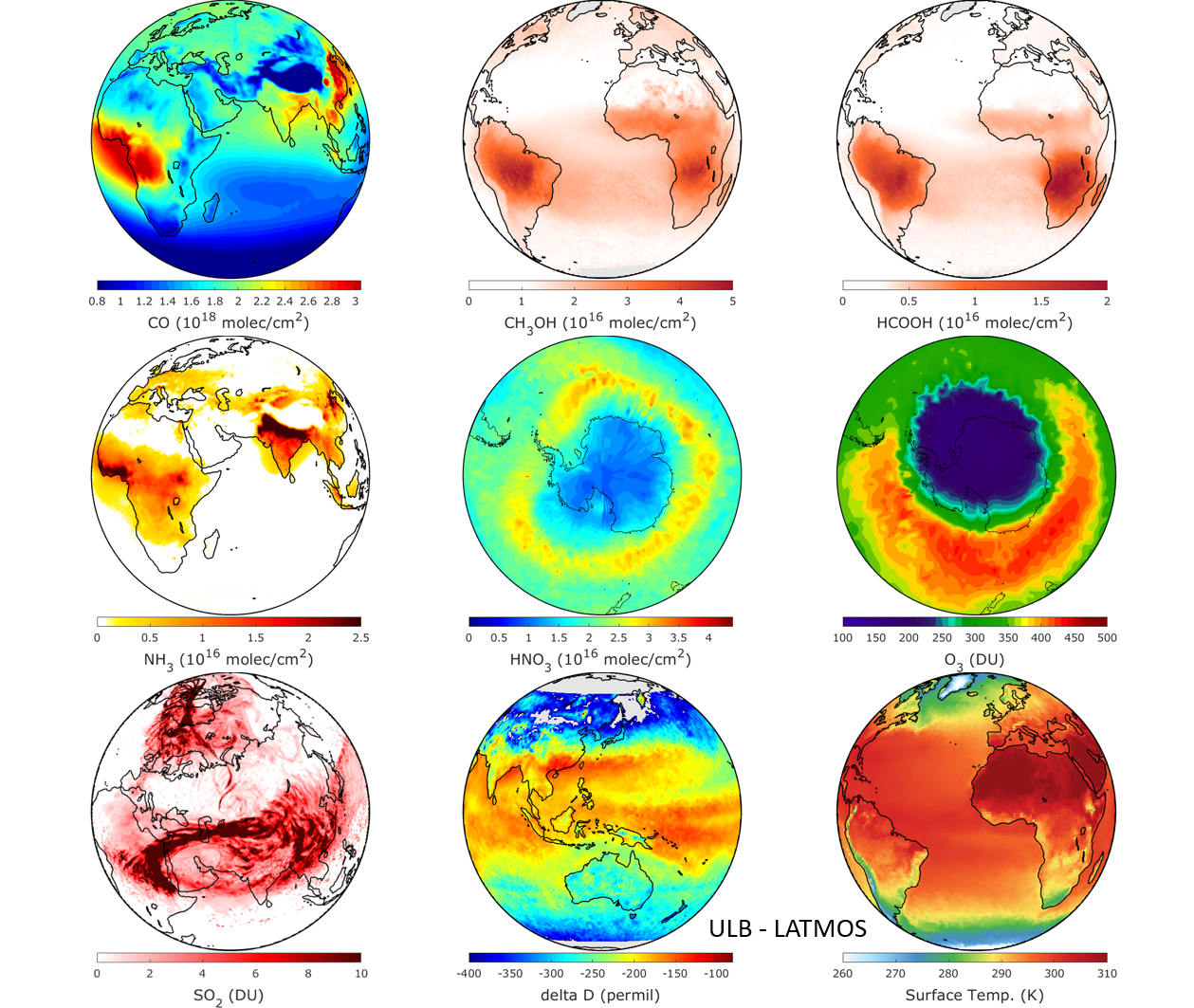Monitoring of atmospheric composition with IASI
The radiance signal recorded by IASI is a composite of the initial longwave infrared emission (the Earth black body emission at the location of the measurement), modified for cloud free scenes by gaseous absorption and emission processes along the path. When a cloud is present in the optical path, the radiance signal recorded by the instrument can be significantly affected, depending on the type (water or ice cloud) and the optical thickness of the cloud. Each molecule has a specific signature resulting from rotation-vibration transitions. The spectral range of IASI was chosen to include the strong absorption features from the carbon dioxide (CO2) absorption band around 15 µm (also used for temperature profile retrievals), the ozone (O3) 9.6 µm band, the strong water vapour absorption band, and up to the edge of Thermal Infrared Radiation (TIR) in the methane (CH4) absorption band (around 3.8 µm). Many other molecular absorptions occur within the IASI spectral range, from which the concentration of additional trace gases can be retrieved (they will be presented afterwards). In addition, surface and cloud properties are derived from transparent windows. It is worth noting that the signal recorded by the instrument contains a contribution from solar backscatter for wavenumbers greater than 2000 cm-1.
The sensitivity of TIR sounders to probe the troposphere varies widely according to the temperature of the surface and the atmosphere. Particularly important for studying local emission sources and the vertical stratification is the difference between the surface temperature and the temperature of the boundary layer, often referred as the thermal contrast. The direct consequence of thermal contrast variations is that the IASI instrument provides more surface sensitive measurements and to some extent better vertical resolution for the morning overpass and over land. Therefore, its ability to probe the planetary boundary layer, where local pollution occurs, and the vertical profile of the atmosphere depends strongly on location, temperature, type of surface and time of the day.
The absorption lines and trace gas concentrations are linked by a nonlinear function of the surface characteristics (emissivity, temperature), the temperature profile at the location of the observation, the atmospheric components interfering in the same spectral range (such as other trace gases, clouds and aerosols), as well as the instrumental characteristics, including the spectral resolution, the radiometric noise and the spectral response function. To retrieve information about the atmosphere, such as surface temperature or atmospheric trace gas concentrations from the measured radiances, an inversion algorithm needs to be applied with some assumptions. For cloud free situations and for species that are optically thin total columns are retrieved, while for some species, like water vapour or ozone, vertical information can be derived, provided that ground emissivity, surface temperature and atmospheric temperature are known at the location of the measurement.
The near-real time L1C data from IASI are collected via a parabolic antenna installed at the roof of Sorbonne Université (Paris 6) in 2008 and are stored on the CICLAD/IPSL cluster. The atmospheric spectra are transmitted from the ground station at the Norwegian island of Spitzberg, which is in direct connection with the Metop satellite. The data are then analysed from different French groups in order to extract the geophysical measurements.
At LATMOS and ULB (Université libre de Bruxelles, Belgium) processing tools have been developed in order to retrieve trace gas concentrations from IASI. Table 1 gives the list of species retrieved from IASI data and, for the group works, corresponding references, where the majority of them can be found in the special issue of the journal Atmospheric Chemistry and Physics dedicated to IASI. IASI detects long-lived species like CO2, N2O, CFC-11, CFC-12, HCFC-22 and OCS (see the special issue), medium-lived species like water vapour and its isotopes, methane, ozone, CO and HNO3, as well as short-lived species like NH3, trace gas from fires (CH3OH, HCOOH, C2H4), SO2 in volcanic plumes and aerosols. It should be mentioned that IASI provided the first high-spatial-resolution global NH3 measurements, although it never targeted ammonia as a product for its mission (the instrumental specifications were not optimized accordingly). Long and medium lived species are observed in each spectrum, while the short-lived species are only detected over specific events or close to emission sources. Examples of IASI measurements can be found in the figure hereinafter, while more information about IASI and its retrievals are provided in Clerbaux et al. (2009).

Table 1 - List of products available from the IASI mission.
For each molecule, when available, the estimated vertical resolution (DOFS, independent information on the vertical),
and accuracy are provided. Long and medium lived species are observed in each spectrum, while the short lived
species are only detected over specific events or close to emission sources (Clerbaux et al., 2009).

Figure 1. Distributions of several species retrieved from IASI observations at LATMOS-ULB (Courtesy Maya George)
More details on the main products retrieved at ULB-LATMOS can be found here: O3, CO, NH3, SO2.


